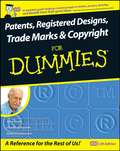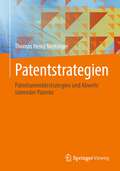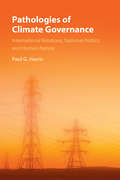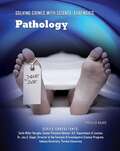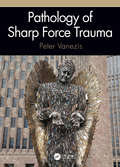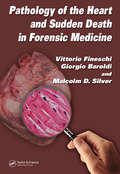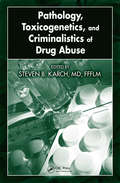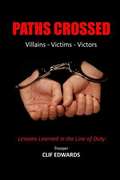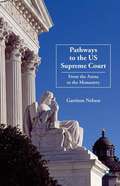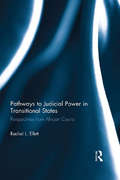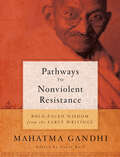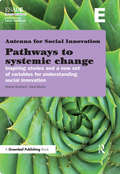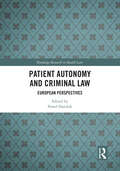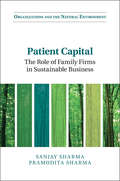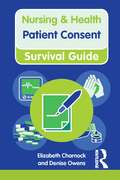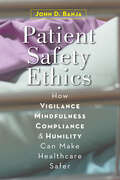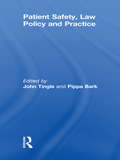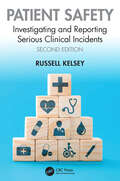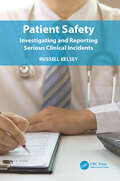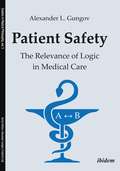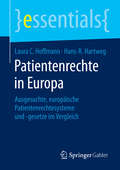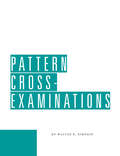- Table View
- List View
Patents, Registered Designs, Trade Marks and Copyright For Dummies
by John Grant Henri J. Charmasson Charlie AshworthDo you have a great idea for the next big thing, an eye-catching new corporate logo, or an exciting new business concept? Understand how to safeguard your ideas and creations with this expert guide to the fundamentals of intellectual property. Walking you step-by-step through the processes involved in protecting your great ideas, this book offers all the advice you need to ensure that you're the only one cashing in on your creativity and hard work.
Patentstrategien: Patentanmeldestrategien und Abwehr störender Patente
by Thomas Heinz MeitingerPatentstrategien können in Patentanmeldestrategien und Strategien zur Abwehr störender Patente unterteilt werden. In aller Regel werden Patente und nicht Patentanmeldungen als störend empfunden, da Patentanmeldungen im Gegensatz zu Patenten nicht durchgesetzt werden können bzw. da es noch überhaupt nicht bekannt ist, was überhaupt der Schutzbereich eines durchsetzungsfähigen Patents aus der Anmeldung sein wird. Der Schutzumfang wird erst durch die Patenterteilung bestimmt. Dann ist es möglich, dass der Schutzumfang der erteilten Anmeldung nicht mehr stört, da das eigene Produkt keine Patentverletzung darstellt. Außerdem ist es möglich, dass sich aus einer Patentanmeldung überhaupt kein Schutzbereich ergibt, da die Patentanmeldung zurückgewiesen wird. Eine Patentanmeldung ist eben ein noch ungeprüftes Schutzrecht. Ein eingetragenes Gebrauchsmuster ist ebenfalls ein ungeprüftes Schutzrecht, obwohl es als vollständig durchsetzbares Schutzrecht gilt. Dennoch wird es der Inhaber eines eingetragenen Gebrauchsmusters schwer haben, eine einstweilige Verfügung ohne vorherige mündliche Anhörung der Gegenseite zu erhalten. Die Chancen hierfür sind bei einem Patent deutlich besser.Der Anmelder einer Patentanmeldung wird sich spätestens kurz vor Ablauf des Prioritätsjahrs vor die Frage gestellt sehen, ob er Nachanmeldungen in ausländischen Ländern vornehmen soll. Hierbei ist es relevant, in welchen Ländern wichtige Märkte für ihn sind und in welchen Ländern die Wettbewerber ihre Produktionsanlagen haben. Außerdem benötigt der Anmelder Informationen, wie am effektivsten und am kostengünstigsten Nachanmeldungen vorzunehmen sind bzw. welche Patentanmeldestrategien angewandt werden können. Dieses Fachbuch gibt dem Leser die Informationen an die Hand, die geeignete Anmeldestrategie zu finden und störende Patente abzuwehren.
Paternalism Beyond Borders
by Barnett Michael N.Nearly all of those who want to make the world a better place are engaged in paternalism. This book asks how power is intertwined with practices of global compassion. It argues that the concept of paternalism illuminates how care and control are involved in the everyday practices of humanitarianism, human rights, development and other projects designed to improve the lives of others. The authors explore whether and how the paternalism of the nineteenth century differs from the paternalism of today, and offer a provocative look at the power in global ethics, raising the question of whether, when, and how paternalism can be justified.
Pathologies of Climate Governance: International Relations, National Politics and Human Nature
by Paul G. HarrisEarth's climate is in crisis. Climate governance has failed. This book diagnoses climate governance as if it were a sick patient, uncovering the fundamental factors causing the worsening climate crisis. It distils decades of global climate negotiations to reveal the features of international relations that are impeding climate action, and it identifies political obstacles to climate governance across a variety of countries in the Americas, Asia, and Europe. The psychosocial aspects of climate change are explored to show how human nature, overconsumption, and global capitalism conspire to stymy climate action. Remedies are suggested for how to overcome hurdles to effective climate governance internationally and nationally, with ideas provided for individuals to help them align their own interests with those of the global environment. Covering all of the major recent events in climate politics and governance, this is an accessible book for concerned readers who want to understand the climate crisis.
Pathology (Solving Crimes With Science: Forensics #12)
by Maryalice Walker"Real-life" crime dramas on television intrigue us with the details of postmortem examinations leading to the arrest of murder suspects--but how do forensic pathologists, the doctors who investigate unnatural deaths and chilling crime scenes, actually bring criminals to justice? The story lies in the body of evidence. Literally. The human body provides a wealth of scientific evidence that allows forensic pathology, or legal medicine, to help resolve criminal cases and convict even most elusive perpetrators. The human body records the story of a crime in the language of cuts, wounds, and bruises, and in the fingerprints and bloodstains. Forensic pathologists are trained to scrutinize and interpret this evidence in ways no other scientist can. Examining victims' remains from the outside in, forensic pathologists investigate every inch of the human landscape to discover when, how, and why the victim died. Sometimes, a time of death is all a jury needs to convict a suspect of murder, and forensic pathologists are experts at uncovering this crucial evidence. Visiting crime scenes, collecting bodies in the middle of the night, and excavating suspicious burial grounds are all in a day's work for the sake of bringing justice to victims who can no longer speak for themselves.
Pathology of Sharp Force Trauma
by Peter VanezisPathology of Sharp Force Trauma illustrates and details sharp force trauma as seen in forensic pathology case work as well as in the clinical setting, outlining how one informs the other in interpreting such trauma for medico-legal purposes. For the purposes of discussion, the author defines sharp force trauma as: "The application of force to produce an injury which results in a clear division or separation of the skin and underlying tissues". Sharp force trauma may be caused by all manner of implements with a sharp edge and/or pointed end, whether or not they have been produced for use as a weapon, and includes knives, broken glass, scissors and many others, to name but a few. Certain tools, such as axes or machetes, combine a sharp edge with heavy weight and produce injuries with both sharp and blunt impact elements. In many countries, with the exception of those where firearms are readily available, sharp force trauma—particularly the use of knives—is the most common method of homicide and a frequent source of morbidity seen in emergency departments. Also, there has recently been an alarming upsurge in the use of knives in gang-related assaults and in terrorist incidents. As such, the book takes a comprehensive approach in explaining the different aspects of such trauma, most importantly the manner in which the victim has died. This includes cases of homicide, suicide or accident, indicating the type of weapon responsible, explaining how it was used, and presenting other such information to the investigation of such cases. Features: • Includes over 400 full-color graphic and illustrative images throughout • Addresses all aspects of the investigation including trauma, crime scene findings, post-mortem examination, characteristics of injuries and categorization into homicide, suicide or accident • Covers the biomechanics of knife trauma and tool mark examination techniques to identify implements used • Illustrates penetrating injuries caused by pointed implements which have linear components, such as arrows, nails, spears, stakes and others • Details cutting, penetrating, and other sharp force injuries resulting from medical intervention in a healthcare environment, such as might occur during surgical procedures • Examines sharp injuries caused by domesticated and wild animals • Written by one of the premier forensic pathologists in the world with over 40 years of first-hand case experience Pathology of Sharp Force Trauma is the first substantive book published in English to look exclusively at this subject. Although primarily intended for pathologists and clinicians who are involved in the examination of such injuries in the post-mortem room or in a hospital environment, it will also be of interest to medical examiners, police and criminal investigators, attorneys and legal professionals, personnel in other forensic disciplines, and all doctors and medical students with an interested in trauma and its management.
Pathology of the Heart and Sudden Death in Forensic Medicine
by Vittorio Fineschi Giorgio Baroldi Malcolm D. SilverAddressing the pathology of the heart and cardiovascular system from a forensic perspective, Pathology of the Heart and Sudden Death in Forensic Investigations guides the pathologist toward the effective resolution of cases. It critically reviews pertinent facts by revisiting pathologic findings and comparing them to etiopathogenic hypotheses, prop
Pathology, Toxicogenetics, and Criminalistics of Drug Abuse
by Steven B. KarchBeginning with a definition and explanation of scheduling of controlled substances, Pathology, Toxicogenetics, and Criminalistics of Drug Abuse covers investigative methods for all illegal drugs and several legitimate pharmaceuticals that are used illicitly, including steroids. It covers the latest techniques used to analyze drugs in the forensic laboratory including physical characteristics and chemical confirmatory tests. It discusses new theories and findings in toxicogenetics, details pathologic changes in the body due to drug use, and examines specific effects on the heart, lung, and central nervous system. More that 70 tables and figures illustrate and complement the text and the information is supported by extensive references
Paths Crossed: Villains - Victims - Victors
by Clif Edwards"When I was only fifteen, a thirty-five year old Deputy Sheriff, married and the father of three daughters, was transporting inmates to a dentist when he was overpowered and killed by a prisoner, who then escaped. Thirteen years later, that murderer and my Paths Crossed. " ~ Clif Edwards Paths Crossed of Villains, Victims & Victors by Michigan State Police Detective Lieutenant Clif Edwards is a true dramatic narrative of everyday heroes and crime drama. It reveals a police officer's evolution from rookie to veteran and its impact, both professionally and personally. Told in a highly inspirational manner, appealing to the general public and its insight to a law enforcement career makes it suggested reading for all criminal justice students. Intended as the first in a trilogy, it is crafted in 76 chapters which follow an orderly theme. Every chapter stands alone as a short story coupled with lessons learned, although many are enriched by prior episodes. Chapters are accented with pictures, articles, documents and quotes. Intriguing, sometimes shocking and always inspiring, it is a must read for all served by law enforcement. These stories allow the reader to experience perseverance, mistake and sacrifice. Foremost, the stark, yet precious reality of law enforcement is made real.
Pathways To The Us Supreme Court
by Garrison Nelson Maggie Steakley James MontaguePathways to the U. S. Supreme Court is a quantitative-historical recapitulation of the routes taken to the US Supreme Court by the 112 Justices who were confirmed by the Senate and served, and the 28 others whose candidacies for confirmation were defeated, withdrawn, or declined
Pathways to Judicial Power in Transitional States: Perspectives from African Courts
by Rachel EllettThis book examines the complex relationship that exists between the construction of judicial power, and the institutional characteristics of the courts and their regime setting. It examines the intriguing connection between the construction of judicial power on the one hand, and the institutional characteristics of the courts and regime setting on the other. The book asks whether courts are rendered powerful by virtue of their institutional characteristics or by a supportive, perhaps acquiescent, regime setting. By analyzing the historical pathways of courts in Uganda, Tanzania and Malawi, this book argues that the emergence of judicial power since the colonial period, though fraught with many challenges, presents a unique opportunity for consolidating democracy. The book examines in detail the significant political decisions of the upper-level courts in Uganda, Tanzania and Malawi from the colonial period to the present day, analyzing them in relation to changes in the political environment over time. Analysis of these decisions is also supplemented by in-depth interviews with judges, lawyers and other important stakeholders in the judicial processes. This book demonstrates that even in the most challenging regime environments, effective institutions and determined individuals can push back against interference and issue politically powerful, independent decisions but the way in which judiciaries respond to this regime pressure varies enormously across countries and regions.
Pathways to Nonviolent Resistance: BOLD-FACED WISDOM from the EARLY WRITINGS (Bold-Faced Wisdom)
by Mohandas Karamchand GandhiIn an age of economic downturns and austerity, when the “Occupy” movement has gone global, this addition to the Bold-Faced Wisdom series couldnt be timelier. Pathways to Nonviolent Resistance re-examines and fully annotates Mahatma Gandhis early writings, offering quick insight into his pragmatic doctrines for effecting peaceful political change and promoting civil rights. Here are Gandhis formative works, the foundation upon which he built his lifelong philosophy: speeches, letters, articles, and other documents drawn from roughly 1893-1923. Key passages are highlighted; "Food for Thought" questions spur readers to think about Gandhis relevance to todays world and their own lives.
Pathways to Systemic Change: Inspiring Stories and a New Set of Variables for Understanding Social Innovation
by David Murillo Heloise BucklandThe world’s social, ecological and economic problems are so complex and diverse that there will never be a “one-size-fits-all” model for social innovation. The very nature of social innovation as a new, better way of solving social problems means that it is not even in the interest of social innovation advocates to create tidy definitions, but rather to create environments that allow for the process of creative destruction with a social purpose to prosper. Inspired by a desire to deepen our understanding of the role of social innovation in addressing today’s most pressing challenges, authors Heloise Buckland and David Murillo explore four inspiring cases and define a new set of variables to help better understand the conditions under which social innovation can be most effective. These variables can be helpful for investors, governments, academic centres, foundations and individual entrepreneurs interested in measuring the potential of any given social innovation to bring about the much-needed systemic change to solve today’s complex challenges. This book builds on a track record of research and education in corporate social responsibility and social entrepreneurship at ESADE Business School’s Institute of Social Innovation. Building on an understanding of the key characteristics and challenges faced by social entrepreneurs, here authors undertake a deeper analysis of social innovation.
Patient Autonomy and Criminal Law: European Perspectives (Routledge Research in Health Law)
by Paweł DanilukThis book shows how the legal systems of individual European countries protect patient autonomy. In particular, it explains the role of criminal law, that is, what criminal law protection of patient autonomy looks like on a European scale in both legal and social dimensions. Despite EU integration processes, the work illustrates that the legal orders of individual European countries are far from uniform in this area. The concept of patient autonomy here is generally in the context of the patient's freedom from unwanted medical activities: the so-called negative freedom. At the same time, in countries where there are no regulations clearly criminalising the performance of a therapeutic activity without the patient's consent, the so-called positive freedom is also discussed. The book will be a valuable reference work for academics, researchers and policy-makers working in Health Law, Medical Ethics, Applied Ethics and Criminal Law.
Patient Capital: The Role of Family Firms in Sustainable Business (Organizations and the Natural Environment)
by Sanjay Sharma Pramodita SharmaSustainable businesses create economic and social value while simultaneously protecting the natural environment for future generations. This examination of environmental sustainability through the lens of the family business identifies factors that help family and non-family organizations address the dilemma of balancing short-term productivity, efficiency and profitability objectives, with innovating for long-term sustainable value creation. Exploring the case of the wine industry - an industry characterized by a variety of governance systems - Sanjay and Pramodita Sharma develop fresh insights into influences and drivers for proactive environmental strategies to address major global sustainability challenges. By doing so, the authors are able to demonstrate that family firms with a focus on trans-generational continuity of business, long temporal orientation, shared vision, faster decision-making processes, and the goal of preserving socio-emotional wealth are more likely to make patient long-term investments for innovations in products, services, processes and business models to address environmental sustainability challenges.
Patient Care: Death and Life in the Emergency Room
by Paul SewardA memoir of over four decades working in the ER:&“Fascinating and engrossing… brimming with humanitarian lessons in medicine and life alike.&” —Kirkus Reviews A Buzzfeed Best Book of the Year A snap judgment about a child nearly has fatal consequences. A priest who may be having a heart attack refuses treatment. An asthmatic man develops air bubbles in his shoulders. A pharmacist is haunted by a decision he makes. Stories like these fill the pages of this memoir of a career that began in the earliest days of the emergency medicine field. In addition to recounting the drama, Dr. Paul Stewart also explores ethical questions that remind us of the full humanity of patients, nurses, coroners, pharmacists, and, of course, doctors. How do they care for strangers in their moments of crisis? How do they care for themselves? Dr. Seward rejects doctor-as-God narratives to write frankly about moments of failure, and champions the role of his colleagues in health care. And for all the moral dilemmas here, there is plenty of wit and humor, too (for example, the patient who punched the author). Readers of Patient Care will find themselves moved, entertained, and occasionally wondering: What would I do? &“In the increasingly popular medical-memoir genre, this one stands out.&”―Booklist &“A fascinating journey through a profession shrouded with mystery.&”―Paul Ruggieri, MD, author of Confessions of a Surgeon &“A generous, compassionate book about what it is to be human and what it is to care…language so clear and compelling you can see straight through it and into the beating heart beneath.&”—Kate Cole-Adams, author of Anesthesia
Patient Consent (Nursing and Health Survival Guides)
by Elizabeth Charnock Denise OwensIdeal for quick reference, this pocket-sized (120x80mm), spiral-bound book in the popular Nursing & Health Survival Guide series puts all the crucial information about patient consent at your fingertips. There is an obligation for practitioners to obtain valid consent from their patients before examination, routine personal care or therapeutic treatment. However, the law relating to consent is complex. Situations may arise where a patient requires urgent treatment, yet is either unwilling or unable to give their consent, or there are concerns over the form and context of the consent. All you need to know on: the underlying principles of consent; consent and the adult patient; consent and the adult who lacks capacity; children and consent; young people and consent.
Patient Safety Ethics: How Vigilance, Mindfulness, Compliance, and Humility Can Make Healthcare Safer
by John D. BanjaDeveloping best practices and ethical systems to protect and enhance patient safety.Human errors occur all too frequently in medical practice settings. One sobering recent report claimed that medical errors are the third leading cause of death in the United States. Hoping to reverse this disturbing trend but wondering why it is that things usually go well despite errors, John D. Banja's Patient Safety Ethics lays out a model that advocates vigilance, mindfulness, compliance, and humility as core ethical principles of patient safety. Arguing that the safe provision of healthcare is one of the most fundamental moral obligations of clinicians, Banja surveys the research literature on harm-causing medical errors to explore the ethical foundations of patient safety and to reduce the severity and frequency of medical error. Drawing on contemporary scholarship on quality improvement, risk management, and medical decision making, Banja also relies on a novel source of information to illustrate patient safety ethics: medical malpractice suits. Providing professional perspective with insights from prominent patient safety experts, Patient Safety Ethics identifies hazard pitfalls and suggests concrete ways for clinicians and regulators to improve patient safety through an ethically cultivated program of "hazard awareness."
Patient Safety, Law Policy and Practice: Law, Policy And Practice
by John Tingle Pippa BarkPatient safety is an issue which in recent years has grown to prominence in a number of countries’ political and health service agendas. The World Health Organisation has launched the World Alliance for Patient Safety. Millions of patients, according to the Alliance, endure prolonged ill-health, disability and death caused by unreliable practices, services, and poor health care environments. At any given time 1.4 million people worldwide are suffering from an infection acquired in a health facility. Patient Safety, Law Policy and Practice explores the impact of legal systems on patient safety initiatives. It asks whether legal systems are being used in appropriate ways to support state and local managerial systems in developing patient safety procedures, and what alternative approaches can and should be utilized. The chapters in this collection explore the patient safety managerial structures that exist in countries where there is a developed patient safety infrastructure and culture. The legal structures of these countries are explored and related to major in-country patient safety issues such as consent to treatment protocols and guidelines, complaint handling, adverse incident reporting systems, and civil litigation systems, in order to draw comparisons and conclusions on patient safety.
Patient Safety: Investigating and Reporting Serious Clinical Incidents
by Russell KelseyThe second edition of this well-received book, the first to provide detailed guidance on how to conduct incident investigations in primary care, has been thoroughly revised and updated throughout to reflect the current nomenclature for different aspects of the investigatory process in the UK and the latest format for incident reporting. Key features: Explains how to recognise a serious clinical incident, how to conduct a root cause analysis (RCA) investigation, and how and when duty of candour applies Covers the technical aspects of serious incident recognition and report writing Includes a wealth of practical advice and 'top tips', including how to manage the common pitfalls in writing reports Offers practical advice as well as some new and innovative tools to help make the RCA process easier to follow Explores the all-important human factors in clinical incidents in detail, with multiple examples and worked-through cases studies as well as in-depth sample reports and analysis. At a time of increasing regulatory scrutiny and medico-legal risk, in which failure to manage appropriately can have serious consequences both for service organisations and for individuals involved, this concise and convenient book continues to provide a master class for anyone performing RCA and aiming to demonstrate learning and service improvement in response to serious clinical incidents. It is essential reading for any clinical or governance leads in primary care, including GP practices, 'out-of-hours', urgent care centres, prison health and NHS 111. It also offers valuable insights to any clinician who is in training or working at the coal face who wishes to understand how serious clinical incidents are investigated and managed.
Patient Safety: Investigating and Reporting Serious Clinical Incidents
by Russell KelseyAt a time of increasing regulatory scrutiny and medico-legal risk, managing serious clinical incidents within primary care has never been more important. Failure to manage appropriately can have serious consequences both for service organisations and for individuals involved. This is the first book to provide detailed guidance on how to conduct incident investigations in primary care. The concise guide: explains how to recognise a serious clinical incident, how to conduct a root cause analysis investigation, and how and when duty of candour applies covers the technical aspects of serious incident recognition and report writing includes a wealth of practical advice and 'top tips', including how to manage the common pitfalls in writing reports offers practical advice as well as some new and innovative tools to help make the RCA process easier to follow explores the all-important human factors in clinical incidents in detail, with multiple examples and worked-through cases studies as well as in-depth sample reports and analysis. This book offers a master class for anyone performing RCA and aiming to demonstrate learning and service improvement in response to serious clinical incidents. It is essential reading for any clinical or governance leads in primary care, including GP practices, 'out-of-hours', urgent care centres, prison health and NHS 111. It also offers valuable insights to any clinician who is in training or working at the coal face who wishes to understand how serious clinical are investigated and managed.
Patient Safety: The Relevance of Logic in Medical Care (Studies In Medical Philosophy Ser. #5)
by Alexander L. GungovIn our time of well-publicized health care travails, in the U.S. and the UK and elsewhere, matters of financing too often subsume the dimension of patient care. In his latest book, Alexander L. Gungov studies a vital but neglected aspect of patient safety. Of the thousands of medical errors committed on a daily basis, in the bulk of unfortunate clinical decisions, a significant share pertains to various logical flows and epistemological fallacies. By focusing on the logical dimensions of clinical medicine, Gungov promotes awareness of the logical and epistemological traps that lie in the day-to-day care of patients. Such a focus not only allows us to avoid falling into them, but demonstrates the practical value of looking at medicine from a new philosophical perspective. That perspective involves a broad and unusual collection of philosophers. The discussion takes its starting point from J. S. Mill’s inductive methods and Giambattista Vico’s verum-factum principle, but then sets out a unique combination of Charles Sanders Peirce’s abductive reasoning, Immanuel Kant’s reflective judgment, as well as G. W. F. Hegel’s and D. P. Verene’s speculative thinking, all marshalled to present a novel philosophical account of clinical diagnostics. Interpretation of practical examples elucidate the logical aspect of medical errors and suggests strategies of overcoming them. The book as a whole demonstrates the value of Hans-Georg Gadamer’s hermeneutical insights into the enigmatic character of health. This much-needed book will be of interest to medical practitioners, health policy makers, patients and their families, and advanced students and scholars in medicine, the medical humanities, medical epistemology, and the philosophy of medicine in general.
Patientenrechte in Europa: Ausgesuchte, europäische Patientenrechtesysteme und -gesetze im Vergleich (essentials)
by Hans-R. Hartweg Laura C. HoffmannLaura C. Hoffmann und Hans-R. Hartweg stellen auf Basis der Regelwerke ausgesuchter europäischer Nationen Vergleiche an, wie dort zum Schutz von Patientinnen und Patienten agiert wird. Nachdem in Deutschland das Patientenrechtegesetz verabschiedet wurde, das im Wesentlichen Patienten-Ansprüche in einer Rechtsgrundlage zusammenführt, ist eine Diskussion entbrannt, ob dieses Gesetz nicht eventuell zu kurz greift. Es kann dabei sinnvoll sein, den Blick auch über internationale Regeln schweifen zu lassen und einen Fokus auf Systeme zu legen, die auf historische oder institutionelle Entwicklungsverläufe schauen, die dem deutschen Gesundheitssystem ähneln. In einigen Nachbarstaaten sind entsprechende Patientenansprüche bereits tief verwurzelt und die Bürgerinnen und Bürger schauen auf eine lange Tradition entsprechender Regelwerke zurück.
Pattern Cross-Examinations
by Walter SimpsonSucceed at cross-examination with these proven strategies, angles of attack and sample questions. Loaded with tips and techniques culled from Walter Simpson's 40+ years of in-the-trenches experience, Pattern Cross-Examinations will help you tackle these tough challenges of cross-examination with ease and finesse: * Dealing with the sarcastic or non-responsive witness * Handling the confrontational witness * Rattling the expert witness * When to ask an open-ended question * When to push a witness and when to back off Model cross-examinations (plaintiff and defense) in common fact patterns are provided for each of these areas of civil litigation: * Auto accidents * Breach of contract * Civil assault and battery * Civil rights * Employment discrimination * Insurance policy litigation * Malicious prosecution * Medical malpractice * Premises liability * Products liability
Pattern Voir Dire Questions
by Susan BroomeYou've been hard at work on your client's behalf for months. Don't leave his fate in the hands of an unfairly biased juror. Pattern Voir Dire Questions covers 26 different types of cases and more than 150 distinct topics, including: * Assault & battery * Breach of contract * Civil rights violations (§1983) * Domestic violence * Employment discrimination * Fraud * Homicide * Medical malpractice * Pain and suffering This helpful book puts more than 1,700 jury voir dire questions at your fingertips. Built from author Susan Broome's 20+ years of experience as a professional trial consultant, Pattern Voir Dire Questions covers a broad range of civil and criminal cases, including written Supplemental Juror Questionnaires that you can use. A Topical Index of Questions gives you an alternative way to find just the right questions for your case and make sure you have covered all the bases.
